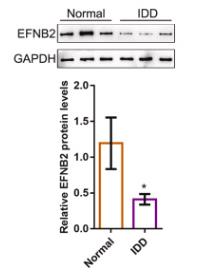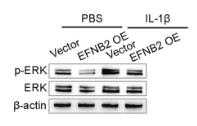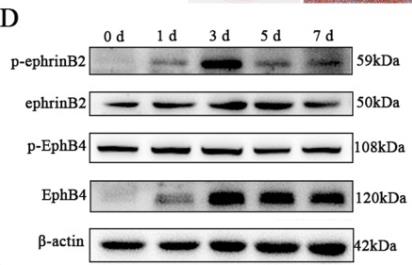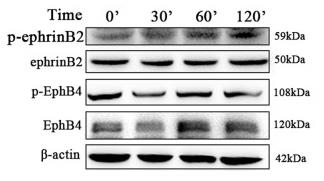Recombinant Human EFNB2 protein(Met1-Ala229), His-tagged
| Cat.No. : | EFNB2-3191H |
| Product Overview : | Recombinant Human EFNB2 (NP_004084.1) (Met 1-Ala 229) was expressed in HEK293, fused with a C-terminal polyhistidine tag. |
| Availability | March 29, 2025 |
| Unit | |
| Price | |
| Qty |
- Specification
- Gene Information
- Related Products
- Case Study
- Application
- Download
| Species : | Human |
| Source : | HEK293 |
| Tag : | His |
| Protein Length : | 1-229 a.a. |
| Form : | Lyophilized from sterile PBS, pH 7.4. Normally 5 % - 8 % trehalose, mannitol and 0.01% Tween80 are added as protectants before lyophilization. |
| Bio-activity : | Measured by its binding ability in a functional ELISA. Immobilized human EFNB2 at 2 μg/ml (100 μl/well) can bind human EphB4 with a linear range of 1.56-12.5 ng/ml. |
| Molecular Mass : | The recombinant human EFNB2 consists of 213 amino acids after removal of the signal peptide and predicts a molecular mass of 23.6 kDa. In SDS-PAGE under reducing conditions, the apparent molecular mass of rh EFNB2 is approximately 35-40 kDa due to glycosylation. |
| Endotoxin : | < 1.0 EU per μg of the protein as determined by the LAL method |
| Purity : | > 97 % as determined by SDS-PAGE |
| Storage : | Samples are stable for up to twelve months from date of receipt at -20°C to -80°C. Store it under sterile conditions at -20°C to -80°C. It is recommended that the protein be aliquoted for optimal storage. Avoid repeated freeze-thaw cycles. |
| Reconstitution : | It is recommended that sterile water be added to the vial to prepare a stock solution of 0.2 ug/ul. Centrifuge the vial at 4°C before opening to recover the entire contents. |
| Gene Name | EFNB2 ephrin-B2 [ Homo sapiens ] |
| Official Symbol | EFNB2 |
| Synonyms | EFNB2; ephrin-B2; EPLG5; eph related receptor tyrosine kinase ligand 5; HTK ligand; Htk L; HTKL; LERK5; ligand of eph related kinase 5; MGC126226; MGC126227; MGC126228; LERK-5; ligand of eph-related kinase 5; eph-related receptor tyrosine kinase ligand 5; Htk-L; |
| Gene ID | 1948 |
| mRNA Refseq | NM_004093 |
| Protein Refseq | NP_004084 |
| MIM | 600527 |
| UniProt ID | P52799 |
| ◆ Recombinant Proteins | ||
| EFNB2-882M | Active Recombinant Mouse EFNB2 Protein, Fc-tagged | +Inquiry |
| Efnb2-1409M | Recombinant Mouse Efnb2 Protein, His-tagged | +Inquiry |
| EFNB2-1374H | Acitve Recombinant Human EFNB2 protein(Met1-Ala229), His&hFc-tagged | +Inquiry |
| Efnb2-1734M | Recombinant Mouse Ephrin B2, Fc-His | +Inquiry |
| Efnb2-367M | Recombinant Mouse Efnb2 Protein, His-tagged | +Inquiry |
| ◆ Cell & Tissue Lysates | ||
| EFNB2-965CCL | Recombinant Canine EFNB2 cell lysate | +Inquiry |
| EFNB2-1540RCL | Recombinant Rat EFNB2 cell lysate | +Inquiry |
| EFNB2-936HCL | Recombinant Human EFNB2 cell lysate | +Inquiry |
| EFNB2-2405MCL | Recombinant Mouse EFNB2 cell lysate | +Inquiry |
Case 1: Zhang Q, et al. Arch Biochem Biophys. 2024
EFNB2 downregulation exacerbates intervertebral disc degeneration by promoting NP cell apoptosis via Bax/Bcl-2 imbalance and caspase-3 activation. Restoring EFNB2 activates PI3K/AKT survival signaling and inhibits ERK phosphorylation, mitigating IL-1β-induced disc degeneration, positioning it as a therapeutic target for spinal health and disc degeneration therapies.

Fig1. EFNB2 protein expression were examined in collected NP tissues using Immunoblotting.

Fig2. NP cells were transduced with EFNB2 OE, treated or non-treated with IL-1β, and examined for the protein levels of p-ERK1/2 and ERK1/2.
Case 2: Wang W, et al. Stem Cell Res Ther. 2020
EphrinB2 overexpression enhances DPSCs’ osteogenic differentiation via EphB4 reverse signaling, boosting alveolar bone regeneration in scaffold-based therapies. In vitro and canine models confirm increased trabecular bone volume, positioning ephrinB2-engineered DPSCs as a breakthrough for bone defect repair and dental regenerative medicine.

Fig1. Expression of p-ephrinB2, ephrinB2, p-EphB4, and EphB4 in hDPSCs during osteogenic differentiation.

Fig2. Western blot analysis confirmed that ephrinB2 reverse signaling was activated by 1 μg/ml EphB4-Fc.

Fig1. Molecular compartmentalization of ephrinB2 and EphB4. (Andras Piffko, 2022)
Not For Human Consumption!
Inquiry
- Reviews
- Q&As
Ask a Question for All EFNB2 Products
Required fields are marked with *
My Review for All EFNB2 Products
Required fields are marked with *
Inquiry Basket


